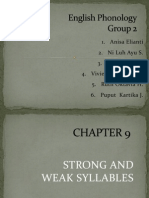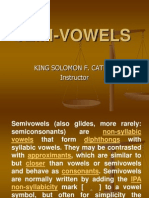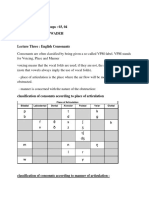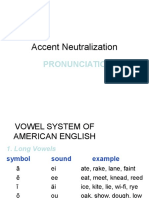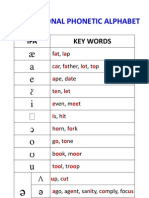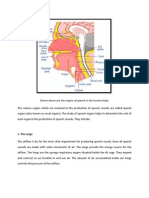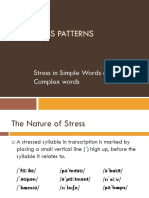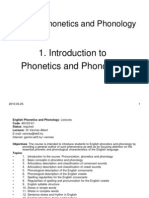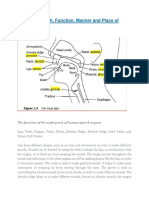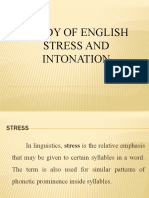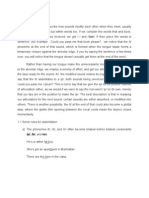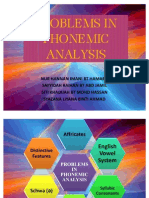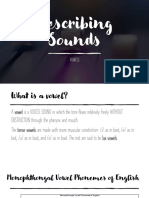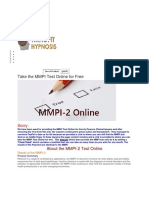Académique Documents
Professionnel Documents
Culture Documents
Phonetics Cheatsheet
Transféré par
andy10223667Titre original
Copyright
Formats disponibles
Partager ce document
Partager ou intégrer le document
Avez-vous trouvé ce document utile ?
Ce contenu est-il inapproprié ?
Signaler ce documentDroits d'auteur :
Formats disponibles
Phonetics Cheatsheet
Transféré par
andy10223667Droits d'auteur :
Formats disponibles
LING/AIS 210 American Indian Languages Spring 2004, IPA Cheat Sheet Page 1 of 3 Transcribing Consonants - the consonants
s used in English (and also in many other languages) English Word Place of Manner of IPA Symbol Word (IPA) Voicing sound is articulation Articulation underlined p pin pn bilabial stop unvoiced b bin bn bilabial stop voiced t tin tn alveolar stop unvoiced d din dn alveolar stop voiced k kin kn velar stop unvoiced g give gv velar stop voiced t chin tn alveolar affricate unvoiced d gin dn alveolar affricate voiced f fin fn labiodental fricative unvoiced v vim vm labiodental fricative voiced thin n interdental fricative unvoiced this s interdental fricative voiced s sin sn alveolar fricative unvoiced z zing z alveolar fricative voiced shin n palatal fricative unvoiced measure mr palatal fricative voiced h hit ht glottal fricative unvoiced m mock mak bilabial nasal voiced n knock nak alveolar nasal voiced thing velar nasal voiced r wrong ra retroflex liquid voiced l long la lateral liquid voiced w wasp wasp bilabial glide voiced j yacht jat palatal glide voiced
LING/AIS 210 American Indian Languages Spring 2004, IPA Cheat Sheet Page 2 of 3 Transcribing Consonants - some consonants not used in English, but found in some American Indian Languages IPA Symbol Comment Language examples: "glottal stop" - this is the sound that's in the English word "Uh oh", and that separates the two Tohono O'odham, Hopi, others syllables of that word from each other. the apostrophe after a consonant means that the consonant is "glottalized". This means that it Western Apache, Navajo, p', k', t' (etc) is articulated with a glottal stop Quechua, others at the same time as the rest of the consonant. "geminate" - this is a consonant that has a long duration compared to the 'non-geminate' pp, kk, tt (etc) Lake Miwok, Shoshoni, others version. Italian is a European language that uses geminate consonants. "labialized" - consonants are articulated with lip rounding, pw, kw, tw Hopi, Shoshoni, others creating a little 'w' sound. "aspirated" - consonants are created with a little extra puff of ph, kh, th air (like the "p" in the English Quechua, Navajo, others word "pin" as opposed to the "p" in the English word "spin"). Transcribing Vowels - vowels used in English, (and also in many other languages) English Word IPA Symbol Word (IPA) height front-back rounding/tension sound is underlined i e a u o peat pit pate pet pat pot putt another ruse put rose caught pit pt pet pt pt pat pt nr ruz pt roz kt high high mid mid low low mid mid high high mid low-mid front front front front front central central central back back back back unround/tense unround/lax unround/tense unround/lax unround/lax unround/lax unround/lax (stressed) unround/lax (unstressed) round/tense round/lax round/tense round/tense
LING/AIS 210 American Indian Languages Spring 2004, IPA Cheat Sheet Page 3 of 3 Transcribing Diphthongs - Diphthongs are vowel-vowel or vowel-glide combinations that are pronounced like a single (vowel) sound: English Word - sound is IPA Symbol Word (IPA) underlined aj j aw rise noise rouse rajz njz rawz
Transcribing Vowels - some vowels not used in English, but found in some American Indian languages IPA Symbol Comment Language examples: "barred-i" This is a sound sort of like the one spelled by - but Tohono O'odham pronounced with the tongue a little higher in the mouth. "Long vowel" - these have the same quality as the IPA value Tohono O'odham, Navajo, Hopi, from the table above, but they other are pronounced with long duration "Voiceless vowel" - sounds like Tohono O'odham a whispered vowel "Nasal vowel" - pronounced with air flow through the nasal Navajo, Western Apache, others cavity as well as the oral cavity
a:, i:, o: etc. or aa, ii, oo etc.
, etc. , , e, etc. or , , etc.
Much of this page was borrowed from the resources made available by : http://www.phon.ucl.ac.uk/home/sampa/english-uni.htm Maintained by J.C. Wells. Created 1995 09 19. Unicode/IPA version 1999 04 29.
Vous aimerez peut-être aussi
- IPA Chart With ExplanationDocument25 pagesIPA Chart With ExplanationLeila Clarianes100% (1)
- Mandarin Chinese PhoneticsDocument11 pagesMandarin Chinese PhoneticsadéjeunerPas encore d'évaluation
- Chapter 9 PhonologyDocument23 pagesChapter 9 PhonologyNie Luh Ayu100% (1)
- Semi-Vowels: King Solomon F. Catral InstructorDocument5 pagesSemi-Vowels: King Solomon F. Catral InstructorKing Solomon CatralPas encore d'évaluation
- Articulatory PhoneticsDocument3 pagesArticulatory PhoneticszelindaaPas encore d'évaluation
- Ipa Stress and IntonationDocument2 pagesIpa Stress and IntonationRuzzel Clarito BaelPas encore d'évaluation
- English Phonetics and PhonologyDocument31 pagesEnglish Phonetics and PhonologyIzzati AzmanPas encore d'évaluation
- Phonetics 3Document13 pagesPhonetics 3Lina MalekPas encore d'évaluation
- IPADocument2 pagesIPAJudy AdamsonPas encore d'évaluation
- Accent Neutralization: PronunciationDocument54 pagesAccent Neutralization: PronunciationJayjay Garcia100% (1)
- PhonologyDocument36 pagesPhonologylearn English by yourself InstagramPas encore d'évaluation
- VowelsDocument18 pagesVowelstiendanghia18101992Pas encore d'évaluation
- Articulators/ Speech Organs: 1. The Larynx & The Vocal FoldsDocument6 pagesArticulators/ Speech Organs: 1. The Larynx & The Vocal FoldsGulfam RiazPas encore d'évaluation
- English Short Vowels and Long VowelsDocument16 pagesEnglish Short Vowels and Long VowelscloudexzPas encore d'évaluation
- IPA TranscriptionsDocument3 pagesIPA TranscriptionsAnonymous lKxkZ9MPas encore d'évaluation
- 1st Year Phonetics Courses S2Document26 pages1st Year Phonetics Courses S2PrinceMino100% (1)
- Voice & Accent NeutralizationDocument71 pagesVoice & Accent Neutralizationerinea081001Pas encore d'évaluation
- Week - 2 - Consonants - and - Vowels - PPT Filename - UTF-8''Week 2 - Consonants and VowelsDocument30 pagesWeek - 2 - Consonants - and - Vowels - PPT Filename - UTF-8''Week 2 - Consonants and VowelsDũng Trần ViệtPas encore d'évaluation
- Phonetics and Phonology Grup 18Document18 pagesPhonetics and Phonology Grup 18Cholif Lespa TrionoPas encore d'évaluation
- The Classification and Description of Speech Sounds in English LanguageDocument6 pagesThe Classification and Description of Speech Sounds in English LanguageNaeemPas encore d'évaluation
- Final Exam LinguisticsDocument5 pagesFinal Exam Linguisticsdomonique tameronPas encore d'évaluation
- Introduction To Phonetic ScienceDocument49 pagesIntroduction To Phonetic ScienceMonMaPas encore d'évaluation
- English Phonetics and Phonology: Profa. Me. Graziela CasagrandeDocument37 pagesEnglish Phonetics and Phonology: Profa. Me. Graziela CasagrandeGrazie_bPas encore d'évaluation
- Phonological RulesDocument1 pagePhonological Ruleskiannatherese andradaPas encore d'évaluation
- Phonemes and Allophones - Minimal PairsDocument5 pagesPhonemes and Allophones - Minimal PairsVictor Rafael Mejía Zepeda EDUCPas encore d'évaluation
- Organs of SpeechDocument5 pagesOrgans of SpeechMohd Shahrin BasniPas encore d'évaluation
- Stress Students'Document37 pagesStress Students'janani a/p ayaooPas encore d'évaluation
- NHA1 - The SyllableDocument11 pagesNHA1 - The Syllable08AV2D100% (1)
- Assimilation RulesDocument13 pagesAssimilation RuleshafidPas encore d'évaluation
- Lecture 3Document41 pagesLecture 3AliPas encore d'évaluation
- نحو ثالثDocument84 pagesنحو ثالثMohammed GallawiPas encore d'évaluation
- English Phonetics and Phonology 01Document18 pagesEnglish Phonetics and Phonology 01Földy Vanda100% (1)
- My Ipa NotesDocument15 pagesMy Ipa Notesmigb24257425100% (2)
- English Sound SystemDocument14 pagesEnglish Sound SystemLovelynedPas encore d'évaluation
- The Syllable: The Pulse' or Motor' Theory of Syllable Production Proposed by The Psychologist RDocument6 pagesThe Syllable: The Pulse' or Motor' Theory of Syllable Production Proposed by The Psychologist RBianca Ciutea100% (1)
- Phonological Processes in Connected SpeechDocument7 pagesPhonological Processes in Connected Speechsara ciullaPas encore d'évaluation
- Swahili QuestionsDocument2 pagesSwahili Questionsquestnvr73Pas encore d'évaluation
- What Is Language?: Linguistic KnowledgeDocument6 pagesWhat Is Language?: Linguistic KnowledgeDendi Darmawan100% (1)
- Manner of ArticulationDocument2 pagesManner of ArticulationzelindaaPas encore d'évaluation
- Xitsonga English ZA L ODocument134 pagesXitsonga English ZA L Omarianaluabo3978Pas encore d'évaluation
- Orgns of SpeechDocument3 pagesOrgns of SpeechAbishekSinghPas encore d'évaluation
- Vowels of English: Presented by Marwa Mahmoud Abd El FattahDocument5 pagesVowels of English: Presented by Marwa Mahmoud Abd El FattahSamar SaadPas encore d'évaluation
- Study of English Stress and Intonation 201221Document21 pagesStudy of English Stress and Intonation 201221Quý Nguyễn100% (1)
- English Consonant Sounds III (Sounds Not Existing in Spanish)Document6 pagesEnglish Consonant Sounds III (Sounds Not Existing in Spanish)Jazmin SanabriaPas encore d'évaluation
- Vowelizing English Consonant Clusters With Arabic Vowel Points Harakaat-Does It Help-July 2014Document20 pagesVowelizing English Consonant Clusters With Arabic Vowel Points Harakaat-Does It Help-July 2014aamir.saeed100% (1)
- Test Phonetics Word Stress 2018correctionDocument4 pagesTest Phonetics Word Stress 2018correctionAngel Angeleri-priftis.Pas encore d'évaluation
- P/, /B/, and /MDocument5 pagesP/, /B/, and /MKumang Sonna JousePas encore d'évaluation
- Discourse MarkersDocument121 pagesDiscourse MarkersVirginia MorenaPas encore d'évaluation
- 4 Phonetics and Phonology: Key ConceptsDocument31 pages4 Phonetics and Phonology: Key ConceptsGaurav BharwanPas encore d'évaluation
- Chu Thi Thuy Tien English and Vietnamese VowelsDocument13 pagesChu Thi Thuy Tien English and Vietnamese VowelsManttresh KumarPas encore d'évaluation
- Problems in Phonemic AnalysisDocument21 pagesProblems in Phonemic AnalysisAiza Hana100% (2)
- Phonology.3 SyllableDocument23 pagesPhonology.3 SyllableMOHAMMAD AGUS SALIM EL BAHRI100% (4)
- IPA Presentación Clase No.1 Fonética IDocument19 pagesIPA Presentación Clase No.1 Fonética Ischiatti3071100% (1)
- Revision Unit 1-13 SSDocument5 pagesRevision Unit 1-13 SSPhương ThảoPas encore d'évaluation
- Phonetics and PhonologyDocument49 pagesPhonetics and PhonologyPatricio SepulvedaPas encore d'évaluation
- Vietnamese Picture Dictionary: Learn 1,500 Vietnamese Words and Expressions - The Perfect Resource for Visual Learners of All Ages (Includes Online Audio)D'EverandVietnamese Picture Dictionary: Learn 1,500 Vietnamese Words and Expressions - The Perfect Resource for Visual Learners of All Ages (Includes Online Audio)Pas encore d'évaluation
- 1.2 Describing Sounds (Lesson 2)Document14 pages1.2 Describing Sounds (Lesson 2)James CancinoPas encore d'évaluation
- Voiced and Voiceless ConsonantsDocument4 pagesVoiced and Voiceless Consonantsmputz100% (1)
- Phonetics PDFDocument29 pagesPhonetics PDFMUHAMMAD SHAHIDPas encore d'évaluation
- 2016 May Virginia Medical Law ReportDocument20 pages2016 May Virginia Medical Law ReportMichael DuntzPas encore d'évaluation
- Erinnerungsmotive in Wagner's Der Ring Des NibelungenDocument14 pagesErinnerungsmotive in Wagner's Der Ring Des NibelungenLaur MatysPas encore d'évaluation
- IdentifyDocument40 pagesIdentifyLeonard Kenshin LianzaPas encore d'évaluation
- Prepositioncombinations PDFDocument14 pagesPrepositioncombinations PDFMichalisBenedictusPas encore d'évaluation
- How To Pay by DBSDocument2 pagesHow To Pay by DBSYe GaungPas encore d'évaluation
- LMC - Boundary Dispute CasesDocument12 pagesLMC - Boundary Dispute CasesLR FPas encore d'évaluation
- Laboratory 1. ANALYSIS OF PLANT PIGMENTS USING PAPER CHROMATOGRAPHYDocument8 pagesLaboratory 1. ANALYSIS OF PLANT PIGMENTS USING PAPER CHROMATOGRAPHYGualberto Tampol Jr.Pas encore d'évaluation
- Programme Guide - PGDMCH PDFDocument58 pagesProgramme Guide - PGDMCH PDFNJMU 2006Pas encore d'évaluation
- Data Flow DiagramDocument21 pagesData Flow Diagrampredikat newsPas encore d'évaluation
- Janet P. Espada Et Al., Challenges in The Implementation of The Mother Tongue-Based Multilingual Education Program:A Case StudyDocument19 pagesJanet P. Espada Et Al., Challenges in The Implementation of The Mother Tongue-Based Multilingual Education Program:A Case StudyAnalyn Bintoso DabanPas encore d'évaluation
- Nunez Rodarte v. Holder, JR., 10th Cir. (2010)Document7 pagesNunez Rodarte v. Holder, JR., 10th Cir. (2010)Scribd Government DocsPas encore d'évaluation
- Global Value Chain: Shikha GuptaDocument19 pagesGlobal Value Chain: Shikha GuptaRushilPas encore d'évaluation
- 2010 - V 8 - PiiDocument149 pages2010 - V 8 - PiiJoe KerrPas encore d'évaluation
- Early Treatment of A Class III Malocclusion With The Myobrace SystemDocument1 pageEarly Treatment of A Class III Malocclusion With The Myobrace SystemThu Trang PhamPas encore d'évaluation
- CONTEXTUALIZED DLP Q1 W1 Day1Document6 pagesCONTEXTUALIZED DLP Q1 W1 Day1QUEENIE BUTALIDPas encore d'évaluation
- Inside The Mind of A Master ProcrastinatorDocument5 pagesInside The Mind of A Master ProcrastinatorDianaPas encore d'évaluation
- PW 1987 01 PDFDocument80 pagesPW 1987 01 PDFEugenio Martin CuencaPas encore d'évaluation
- Biotransformation of DrugsDocument36 pagesBiotransformation of DrugszeepharmacistPas encore d'évaluation
- Let's DanceDocument6 pagesLet's DancethierrystePas encore d'évaluation
- Wheel Loader wl56Document6 pagesWheel Loader wl56Shahzad AliPas encore d'évaluation
- Take The MMPI Test Online For Free: Hypnosis Articles and InformationDocument14 pagesTake The MMPI Test Online For Free: Hypnosis Articles and InformationUMINAH0% (1)
- Building Planning & DrawingDocument5 pagesBuilding Planning & Drawingshreeprashant849160% (5)
- Batangas Polytechnic College: The Morning After Case 7Document4 pagesBatangas Polytechnic College: The Morning After Case 7Jonard Marco RomeroPas encore d'évaluation
- A Financial Analysis of Alibaba Group Holding LTDDocument26 pagesA Financial Analysis of Alibaba Group Holding LTDSrinu Gattu50% (4)
- Mao InoueDocument9 pagesMao InoueNemanja IlicPas encore d'évaluation
- SWOC AnalysisDocument5 pagesSWOC AnalysisSyakirah HeartnetPas encore d'évaluation
- Chapter 18 Metric and Imperial Measures: Scheme of WorkDocument2 pagesChapter 18 Metric and Imperial Measures: Scheme of WorkrightwayPas encore d'évaluation
- SAP BW Certification ExamDocument2 pagesSAP BW Certification Examferozece90% (1)
- 4.08 Intermediate Category of Taxation and Attorney and Own Client CostsDocument4 pages4.08 Intermediate Category of Taxation and Attorney and Own Client CostsBarbraPas encore d'évaluation
- Paper-CutoutDocument5 pagesPaper-CutoutmauricioPas encore d'évaluation


